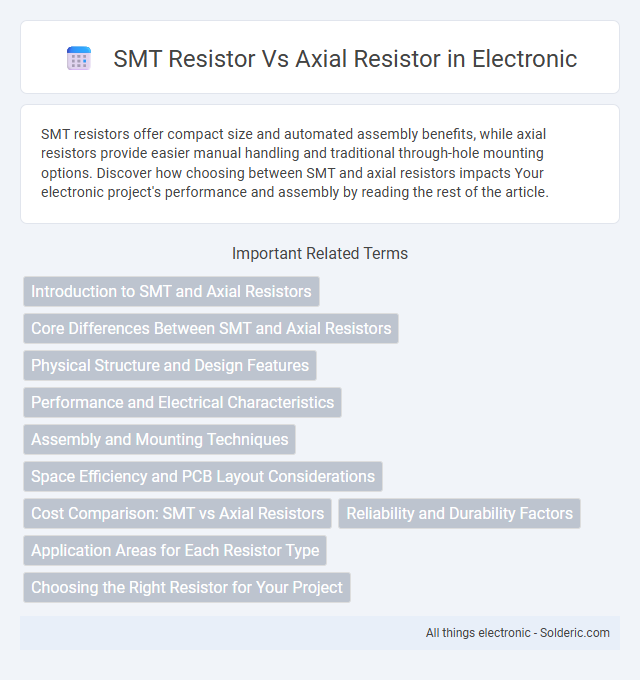SMT resistors offer compact size and automated assembly benefits, while axial resistors provide easier manual handling and traditional through-hole mounting options. Discover how choosing between SMT and axial resistors impacts Your electronic project's performance and assembly by reading the rest of the article.
Comparison Table
| Feature | SMT Resistor | Axial Resistor |
|---|---|---|
| Mounting Style | Surface Mount Technology (SMT) | Through-Hole (Axial Lead) |
| Size | Compact, small footprint | Larger, longer body with leads |
| Application | High-density PCB designs | Prototyping, high power, easy replacement |
| Power Rating | Typically 0.1W to 1W | Typically 0.25W to 5W or more |
| Assembly | Automated pick-and-place machines | Manual soldering, easier to handle |
| Reliability | Better for vibration and shock | More prone to mechanical stress |
| Cost | Lower cost in mass production | Higher cost per unit, simpler production |
Introduction to SMT and Axial Resistors
Surface Mount Technology (SMT) resistors are compact, rectangular components designed for automated placement on printed circuit boards (PCBs), offering high precision and efficient use of space in modern electronics. Axial resistors feature a cylindrical body with leads extending from both ends, suitable for through-hole mounting, providing mechanical stability and ease of manual assembly. Both resistor types serve critical roles in electronic circuits, with SMT resistors favored for miniaturization and axial resistors preferred in applications requiring robust physical connections.
Core Differences Between SMT and Axial Resistors
SMT resistors are surface-mount components designed for automated assembly, offering compact size and better performance in high-frequency circuits compared to axial resistors, which feature wire leads for through-hole mounting and easier manual handling. Core differences include mounting style, with SMT resistors soldered directly onto the PCB surface, while axial resistors are inserted into holes and soldered, affecting their thermal performance and mechanical stability. Your choice depends on application needs, as SMT resistors suit modern miniaturized electronics, whereas axial resistors are preferred for prototyping and repairs.
Physical Structure and Design Features
SMT resistors feature a compact, rectangular ceramic substrate with metal terminations on either end, designed for automated surface mounting on printed circuit boards, enabling high-density assembly and superior thermal performance. Axial resistors have a cylindrical body with wire leads extending from both ends, allowing through-hole mounting and easier manual handling or prototyping. The low profile and precise dimensions of SMT resistors support miniaturization trends in electronics, while axial resistors provide mechanical flexibility and robustness for applications requiring strain relief.
Performance and Electrical Characteristics
Surface Mount Technology (SMT) resistors offer superior high-frequency performance and lower parasitic inductance compared to axial resistors, making them ideal for modern compact circuits requiring precise signal integrity. Axial resistors generally have higher power ratings and better thermal dissipation, which benefits applications with higher current loads or power dissipation needs. Your choice between SMT and axial resistors significantly impacts circuit reliability and performance, depending on the electrical characteristics and physical constraints of your design.
Assembly and Mounting Techniques
SMT resistors are designed for surface-mount technology, allowing automated placement directly onto PCB pads, which enhances assembly speed and accuracy compared to axial resistors. Axial resistors require through-hole mounting, involving manual insertion and soldering, which can increase labor time and complexity in high-volume production. Your choice between SMT and axial resistors impacts manufacturing efficiency and suitability for compact circuit designs.
Space Efficiency and PCB Layout Considerations
SMT resistors offer superior space efficiency compared to axial resistors, enabling higher component density on your PCB and allowing for more compact designs. The smaller footprint and absence of leads reduce the complexity of PCB layout, facilitating automated assembly and minimizing parasitic inductance. Axial resistors require more board space and manual handling, potentially complicating routing and limiting the overall miniaturization of electronic devices.
Cost Comparison: SMT vs Axial Resistors
SMT resistors typically offer lower manufacturing and assembly costs due to automated placement and smaller size, which reduces material usage and production time. Axial resistors, although generally costlier per unit, may incur higher labor expenses in manual insertion and wave soldering processes. Your choice between SMT and axial resistors should consider these cost implications alongside your specific application needs.
Reliability and Durability Factors
SMT resistors offer superior reliability and durability due to their compact size, which reduces mechanical stress and enhances heat dissipation compared to axial resistors. Axial resistors, with their leaded design, are more susceptible to vibration and physical damage, potentially compromising long-term performance. The robust construction and stable materials used in SMT resistors contribute to consistent electrical characteristics under harsh environmental conditions.
Application Areas for Each Resistor Type
SMT resistors excel in compact electronic devices like smartphones, laptops, and wearables due to their small footprint and automated assembly compatibility, making them ideal for high-density circuit boards. Axial resistors are commonly used in through-hole applications such as industrial equipment, power supplies, and audio devices, where mechanical stability and ease of manual soldering are critical. Each resistor type caters to different assembly techniques and environmental robustness requirements in their respective application areas.
Choosing the Right Resistor for Your Project
Selecting the right resistor for your project depends on factors such as size constraints, power rating, and mounting preferences; SMT resistors offer compact size and suitability for automated PCB assembly, making them ideal for high-density circuits. Axial resistors provide easier manual handling and are preferred in prototyping or applications requiring higher power dissipation. Evaluating circuit layout, thermal management, and assembly method ensures optimal performance and reliability between SMT and axial resistor options.
SMT Resistor vs Axial Resistor Infographic

 solderic.com
solderic.com